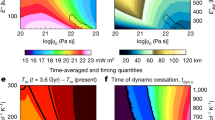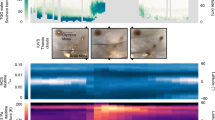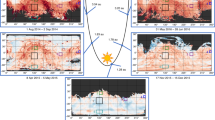Abstract
The surface of the Martian moon Phobos exhibits two distinct geologic units, red and blue, characterized by their spectral slopes. The provenance of these units is uncertain yet crucial to understanding the origin of the Martian moon and its interaction with the space environment. Here we present a combination of dynamical analyses and numerical simulations of particle dynamics to show that periodic variations in dynamic slopes, driven by orbital eccentricity, can cause surface grain motion. For regions with steep slopes that vary substantially over one Phobos orbit, the surface is excavated at a faster rate than the space weathering timescale. Our model predicts that this new mechanism is most effective in regions that coincide with blue units. Therefore, space weathering is the likely driver of the dichotomy on the moon’s surface, reddening blue units that represent pristine endogenic material.
This is a preview of subscription content, access via your institution
Access options
Access Nature and 54 other Nature Portfolio journals
Get Nature+, our best-value online-access subscription
$29.99 / 30 days
cancel any time
Subscribe to this journal
Receive 12 print issues and online access
$259.00 per year
only $21.58 per issue
Buy this article
- Purchase on Springer Link
- Instant access to full article PDF
Prices may be subject to local taxes which are calculated during checkout





Similar content being viewed by others
Code availability
The code used to generate the datasets is available from the corresponding author on reasonable request.
Data availability
The datasets generated and analysed during the current study are available from the corresponding author on reasonable request.
References
Shi, X., Oberst, J. & Wilner, K. Mass wasting on Phobos triggered by an evolving tidal environment. Geophys. Res. Lett. 43, 12371–12379 (2016).
Hurford, T. A. et al. Tidal disruption of Phobos as the cause of surface fractures. J. Geophys. Res. 121, 1054–1065 (2016).
Fraeman, A. A. et al. Spectral absorptions on Phobos and Deimos in the visible/near infrared wavelengths and their compositional constraints. Icarus 229, 196–205 (2014).
Basilevsky, A. T. et al. The surface geology and geomorphology of Phobos. Planet. Space Sci. 102, 95–118 (2014).
Pieters, C. M., Murchie, S., Thomas, N. & Britt, D. Composition of surface materials on the moons of Mars. Planet. Space Sci. 102, 144–151 (2014).
Murchie, S. L., Thomas, P. C., Rivkin, A. S. & Chabot, N. L. in Asteroids IV (eds Michel, P. et al.) 451–467(Univ. of Arizona Press, Tucson, 2015).
Hapke, B. Space weathering from Mercury to the asteroid belt. J. Geophys. Res. Planets 106, 10039–10073 (2001).
Vernazza, P., Binzel, R. P., Rossie, A., Fulchignoni, M. & Birlan, M. Solar wind as the origin of rapid weathering of asteroid surfaces. Nature 458, 993–995 (2009).
Kaluna, H. M., Masiero, J. R. & Meech, K. J. Space weathering trends among carbonaceous asteroids. Icarus 264, 62–71 (2016).
Binzel, R. P. et al. Earth encounters as the origin of fresh surfaces on near-Earth asteroids. Nature 463, 331–334 (2010).
Fraeman, A. A. et al. Analysis of disk-resolved OMEGA and CRISM spectral observations of Phobos and Deimos. J. Geophys. Res. 117, E00J15 (2012).
Thomas, N. et al. Spectral heterogeneity on Phobos and Deimos: HiRISE observations and comparisons to Mars Pathfinder results. Planet. Space Sci. 59, 1281–1292 (2011).
Kawakatsu, Y. et al. M. Mission concept of Martian Moons eXploration (MMX). In 68th International Astronautical Congress IAC-17-A3.3A.5 (2017).
Werner, R. A. & Scheeres, D. J. Exterior gravitation of a polyhedron derived and compared with harmonic and mascon gravitation representations of asteroid 4769 Castalia. Celest. Mech. Dyn. Astron. 65, 313–344 (1996).
Broucke, R. Stability of periodic orbits in the elliptic, restricted three-body problem. AIAA J. 7, 1003–1009 (1969).
Richardson, D. C., Walsh, K. J., Murdoch, N. & Michel, P. Numerical simulations of granular dynamics: I. Hard-sphere discrete element method and tests. Icarus 212, 427–437 (2011).
Schwartz, S. R., Richardson, D. C. & Michel, P. An implementation of the soft-sphere discrete element method in a high-performance parallel gravity tree-code. Granul. Matter 14, 363–380 (2012).
Culling, E. H. Analytical theory of erosion. J. Geol. 68, 336–344 (1960).
Richardson, J. E. & Bowling, T. J. Investigating the combined effects of shape, density, and rotation on small body surface slopes and erosion rates. Icarus 234, 53–65 (2014).
Richardson, J. E., Melosh, H. J., Greenberg, R. J. & O’Brien, D. P. The global effects of impact-induced seismic activity on fractured asteroid surface morphology. Icarus 179, 325–349 (2005).
Roering, J. J., Kirchner, J. W. & Dietrich, W. E. Evidence for nonlinear, diffusive sediment transport on hillslopes and implications for landscape morphology. Water Resour. Res. 34, 853–870 (1999).
Shingareva, T. V. & Kuzmin, R. O. Mass-wasting processes on the surface of Phobos. Sol. Syst. Res. 35, 431–443 (2001).
Collins, G. S. & Melosh, H. J. Acoustic fluidization and the extraordinary mobility of sturzstroms. J. Geophys. Res. 108, 2473 (2003).
Thomas, P. C. Ejecta emplacement on the Martian satellites. Icarus 131, 78–106 (1998).
Karachevtseva, I. P. et al. The Phobos information system. Planet. Space Sci. 102, 74–85 (2014).
Patsyn, V. et al. Spectrometric characteristics of the surface of Phobos from data obtained by HRSC on Mars Express. In European Planetary Science Congress, Madrid EPSC2012-197 (2012).
Johnson, T. V. & Fanale, F. P. Optical properties of carbonaceous chondrites and their relationship to asteroids. J. Geophys. Res. 78, 8507–8518 (1973).
Shepard, M. K. et al. Multi-wavelength observations of Asteroid 2100 Ra-Shalom. Icarus 193, 20–38 (2008).
Murchie, S. & Erard, S. The spectral properties and composition of Phobos from measurements by Phobos 2. Icarus 123, 63–86 (1996).
Iverson, R. M. The physics of debris flows. Rev. Geophys. 35, 3 (1997).
Pieters, C. M. & Noble, S. K. Space weathering on airless bodies. J. Geophys. Res. 121, 1865–1884 (2016).
Lucey, P. et al. in New Views of the Moon (eds Jolliff, B. L. et al.) 83–219 (Mineralogical Society of America, Washington DC, 2006).
Burns, J. A. The dynamical evolution and origin of the Martian moons. Vistas Astron. 22, 193–208 (1978).
Hansen, B. M. S. A dynamical context for the origin of Phobos and Deimos. Mon. Not. Roy. Astron. Soc. 475, 2452–2466 (2018).
Craddock, R. A. Are Phobos and Deimos the result of a giant impact? Icarus 211, 1150–1161 (2011).
Hyodo, R., Genda, H., Charnoz, S. & Rosenblatt, P. On the impact origin of Phobos and Deimos. I. thermodynamic and physical aspects. Astrophys. J. 845, 125–133 (2017).
Canup, R. & Salmon, J. Origin of Phobos and Deimos by the impact of a Vesta-to-Ceres sized body with Mars. Sci. Adv. 4, eaar6887 (2018).
Pignatale, F. C. et al. On the impact origin of Phobos and Deimos. III. Resulting composition from different impactors. Astrophys. J. 853, 12 (2018).
Glotch, T. D. et al. MGS-TES spectra suggest a basaltic component in the regolith of Phobos. J. Geophys. Res. 123, 2467–2484 (2018).
Gundlach, B. & Blum, J. A new method to determine the grain size of planetary regolith. Icarus 223, 479–492 (2013).
Scheeres, D. J. & Marzari, F. Spacecraft dynamics in the vicinity of a comet. J. Astronaut. Sci. 50, 35–52 (2002).
Willner, K., Shi, X. & Oberst, J. Phobos’ shape and topography models. Planet. Space Sci. 102, 51–59 (2014).
Pätzold, M. et al. Phobos mass determination from the very close flyby of Mars Express in 2010. Icarus 229, 92–98 (2014).
Zhang, Y. et al. Creep stability of the proposed AIDA mission target 65803 Didymos: I. Discrete cohesionless granular physics model. Icarus 294, 98–123 (2017).
Busch, M. W. et al. Arecibo radar observations of Phobos and Deimos. Icarus 186, 581–584 (2007).
Jiang, M., Shen, Z. & Wang, J. A novel three-dimensional contact model for granulates incorporating rolling and twisting resistances. Comput. Geotech. 65, 147–163 (2015).
Sasaki, S. Surface properties of Phobos/Deimos and formation of self-sustained Martian dust torus. Lunar Planet. Sci. Conf. 26, 1219–1220 (1995).
Scheeres, D. J., Hartzell, C. M., Sánchez, P. & Swift, M. Scaling forces to asteroid surfaces: the role of cohesion. Icarus 210, 968–984 (2010).
Hartzell, C. & Scheeres, D. J. Dynamics of levitating dust particles near asteroids and the Moon. J. Geophys. Res. 118, 116–125 (2013).
Farrel, W. M. et al. Anticipated electrical environment at Phobos: nominal and solar storm conditions. Adv. Space Res. 62, 2199–2212 (2017).
Zhang, Y. et al. Rotational failure of rubble-pile bodies: influences of shear and cohesive strengths. Astrophys. J. 857, 15–35 (2018).
Jewitt, D. & Meech, K. J. Cometary grain scattering versus wavelength, or ‘What color is comet dust’? Astrophys. J. 310, 937–952 (1986).
Lazzarin, M. et al. Space weathering in the main asteroid belt: The big picture. Astrophys. J. 647, L179–L182 (2006).
Keller, L. P. et al. Direct determination of the space weathering rates in lunar soils and Itokawa regolith from sample analyses. Lunar Planet. Sci. Conf. 47, 2525 (2016).
Hawke, B. R. et al. The origin of lunar crater rays. Icarus 170, 1–16 (2004).
Acknowledgements
R.-L.B acknowledges support from JAXA’s Aerospace Project Research Associate Program. N.B. conducted this work as a JSPS International Research Fellow. S.T.C. was supported by the JAXA International Top Young Fellowship Program. The authors also thank P. Michel for constructive feedback on the results and implications of this work. Grain dynamics simulations were calculated on the YORP cluster run by the Center for Theory and Computation at the Department of Astronomy at the University of Maryland. For data visualization, the authors made use of the freeware, multi-platform, ray-tracing package, Persistence of Vision Raytracer.
Author information
Authors and Affiliations
Contributions
R.-L.B. conceptualized the study, designed and performed the local simulations of granular dynamics, and led the research. N.B. initiated the project through a study of the three-body elliptical problem on Phobos, performed the gravitational dynamics calculations, and contributed to the analyses. S.T.C. provided geophysical and geomorphological expertise, remote-sensing analysis, and constructed the model for regolith development on Phobos. Y.K. provided guidance and advice on the formulation and scope of the research. M.F. provided guidance and discourse on the implications of the results. Y.K. and M.F. provided expertise in small-body exploration and contextualized the research in the frame of the MMX mission. All authors contributed to the interpretation of the results and preparation of the manuscript.
Corresponding author
Ethics declarations
Competing interests
The authors declare no competing interests.
Additional information
Publisher’s note: Springer Nature remains neutral with regard to jurisdictional claims in published maps and institutional affiliations.
Rights and permissions
About this article
Cite this article
Ballouz, RL., Baresi, N., Crites, S.T. et al. Surface refreshing of Martian moon Phobos by orbital eccentricity-driven grain motion. Nat. Geosci. 12, 229–234 (2019). https://doi.org/10.1038/s41561-019-0323-9
Received:
Accepted:
Published:
Issue Date:
DOI: https://doi.org/10.1038/s41561-019-0323-9
This article is cited by
-
High-resolution shape models of Phobos and Deimos from stereophotoclinometry
Earth, Planets and Space (2023)
-
Measuring the mechanical properties of small body regolith layers using a granular penetrometer
Astrodynamics (2023)
-
Long-term trends of regolith movement on the surface of small bodies
Nonlinear Dynamics (2022)
-
MMX geodesy investigations: science requirements and observation strategy
Earth, Planets and Space (2021)
-
Implantation of Martian atmospheric ions within the regolith of Phobos
Nature Geoscience (2021)



